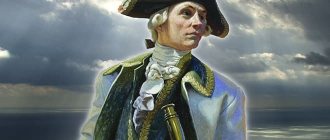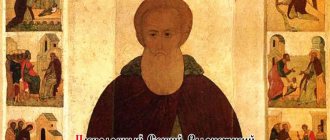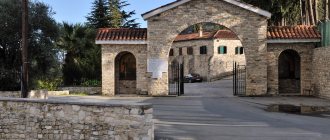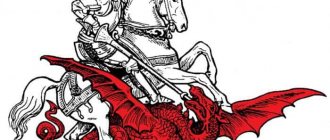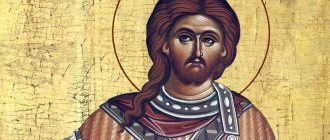Date in 2022: May 6, Thursday.
The Day of St. George the Victorious is celebrated on May 6; there are also other dates for commemorating this saint. He patronizes warriors, defenders of the homeland, his image is present on the coat of arms of Russia.
| When is it celebrated? | May 6 There are also other days of veneration of the saint. |
| When was it founded | 303, when the holy martyr departed to the Lord. Special veneration dates back to 1030, when Y. the Wise founded the Yuryevsky Temple. |
| Traditions | Divine services, prayer services, prayers (in Rus' they asked for healing for people, families and livestock), rolling on the ground, meals in nature, various actions to protect from bad weather. |
Christianity has many significant dates dedicated to historical heroes. In Orthodoxy and Catholicism, the day of St. George the Victorious is widely known. The Great Martyr is considered the people's patron of the army and the Russian state.
The celebration of this date is always bright. The saint is an example of courage, boldness and bravery for all people.
When is St. George's Memorial Day in 2022?
The Day of Remembrance of St. George the Victorious is celebrated four times in 2022.
- May 6
is the day of remembrance (repose) of St. George the Victorious. - November 16
- renovation of the Church of the Great Martyr George in Lydda in the 4th century. - November 23
– Wheeling of St. George. - December 9
- the memory of the consecration of the Church of the Holy Great Martyr George by Prince Yaroslav the Wise in Kiev.
According to the old style, the day of memory of St. George the Victorious was celebrated on the church calendar on April 23. The renovation of the Church of St. George the Victorious in Lydda is celebrated according to the old style on November 4. The wheeling of St. George the Victorious according to the old style church calendar is celebrated on November 10. Commemoration of the consecration of the Church of the Holy Great Martyr George by Prince Yaroslav the Wise in Kyiv according to the old style - November 26. The dates are not moving; they are celebrated by the Orthodox Church on the same day every year.
When do we celebrate?
Often people who are not very knowledgeable about church holidays have a question: what date is the feast of St. George the Victorious? The veneration of this man in Russia has become very important. To this day, the image of his feat is depicted on coins and in the center of the coat of arms.
George is remembered as an intercessor of Christians, a generous, kind and decent hero, and he was also a true righteous man. Experiencing so much suffering, he did not think for a second about renouncing his faith. It is this act of his that serves as a kind of guiding star, a real example for all Orthodox people. And the image of George piercing a serpent with a spear, familiar to almost everyone, is directly related to the feat thanks to which a large number of people were converted to Christianity.
It is May 6th that is the Orthodox holiday of St. George the Victorious, which many people know about. Those who consider themselves to be true Christians.
Life of St. George the Victorious
George was born in the city of Belit in Lebanon, probably in 276. It is known that his parents were quite wealthy Christians. The boy lost his father early, who was tortured for his faith. George received a good education and went to military service. Thanks to his talents, he received the title of commander of a thousand, and after showing courage in the war with the Persians, he was appointed to the personal guard by the governor's committee.
Diocletian was a talented ruler, but an ardent supporter of paganism; during his reign there were the most severe persecutions of Christians. When George heard the order to exterminate Christians, he sympathized with the persecuted. Assuming that torment awaited him too, George distributed everything he had to the poor, and at a meeting where Diocletian was present, he said that he was mistaken in his faith. He denounced the ruler for cruelty and injustice, and confessed his faith.
The emperor ordered George to be imprisoned in a cell and tortured. St. George the Victorious bravely endured all the tortures, and when he himself came off the wheel after them, some officials wanted to convert to Christianity. For such disobedience, Diocletian gave the order to execute the dignitaries. The Great Martyr himself was thrown into a pit and covered with lime, believing that it would burn him. Three days later, George was alive and unharmed; they pulled him out and continued to torture him until God called him to himself. People, having learned about the miracles that happened to St. George the Victorious, began to grumble.
Even the emperor's wife, Alexandra, supported George, for which she was also executed. The Church calls the Great Martyr George for his courage and for his undoubted spiritual victory over the executioners, who subjected him to the most severe tortures, but were never able to force him to renounce the holy Christian faith, the Victorious.
Don't touch the comb!
It has already become clear that the holiday of St. George the Victorious is considered really big. What should you not do on this day?
They say that on such a great holiday you should not use combs, combs, scissors and brushes. And old people also mention that these objects should be hidden further away so that they do not catch the eye. This example has two not very good consequences.
Firstly, if someone decides to cut their hair or simply comb their hair, the hair will become weaker and gradually begin to fall out.
Secondly, there is an opinion that by acting contrary to the rules, you can lose your wet nurse, that is, a cow. The animal will not die, but the calves will no longer be born, therefore, there will be no milk.
Where are the relics of the saint?
While still in prison and foreseeing his death, Saint George asked his servant to take his body to Palestine. After George departed to God, the servant fulfilled this command, and the saint’s body was transported and buried in the city of Ramla. During the reign of Emperor Constantine, a beautiful temple was built in Lydda in honor of St. George the Victorious, and the incorruptible relics of St. George the Victorious were transferred here from Ramla.
After many years, this beautiful temple turned out to be neglected; the altar and the saint’s coffin remained intact. Thanks to donations, the temple in Lydda was restored and re-consecrated on the same day it was first done.
November 10/23 – Wheeling of the Holy Great Martyr George
Georgia, enlightened by the Christian faith by Saint Nina Equal to the Apostles († 335), a relative of the Holy Great Martyr George the Victorious († 303, Comm. April 23), especially honors Saint George as its patron. One of the names of Georgia is in honor of George (this name is still preserved in many languages of the world). In honor of the Great Martyr, Saint Nina established a holiday. It is still celebrated in Georgia on November 10 - in memory of the wheeling of St. George. In 1891, in the Caucasus, near the village of Kakhi, Zagatala district, a new temple was built on the site of an ancient one in honor of the Holy Great Martyr George the Victorious, to which many pilgrims of different faiths flock.
What do people pray to St. George the Victorious for?
St. George the Victorious is considered the patron saint of the Russian army; many victories in Tsarist and Soviet times are associated with his holy name. Before the revolution, awards included the Order of St. George, the Cross of St. George and the Medal of St. George. In honor of the founder of Moscow, Prince Yuri Dolgoruky (Yuri is the Russian version of the name George), St. George the Victorious is depicted on the ancient coat of arms of Moscow.
According to legend, the miracle of St. George the Victorious in protecting the inhabitants and their herds from the serpent was the reason for the veneration of St. George as the protector of cattle breeders. Before the revolution, on the day of his memory, peasants sprinkled animals with holy water.
St. George the Victorious helps people who turn to him for help to protect them from enemies and gain victory and peace. The Holy Great Martyr also helps in curing serious illnesses; there is evidence of deliverance from women's problems.
The Holy Great Martyr George helps everyone who has faith that his request will be heard and fulfilled. All the suffering that the Great Martyr George the Victorious endured, he endured for the Orthodox faith, which he did not betray and did not exchange for wealth and power.
We live according to signs
A truly great day is the feast of St. George the Victorious. We will recall the signs and customs dedicated specifically to him in this article.
First, we need to remind you that people consider this the day of the final entry into their rights of spring. Winter will now not disturb the earth for a very long time. Now nature has woken up, everything is turning green, waking up and starting to live.
It is believed that if it is a quiet and clear morning on Yegoria, then the first crops of the year will be very fruitful. This sign does not apply to cereals, but to those vegetables that are planted with seeds. If gardeners sow tomatoes, cucumbers, peppers or radishes (they sow, not plant seedlings), then they will soon reap their first harvest.
There is another sign according to which they look at the size of birch leaves. If on the sixth of May they are the size of a half coin (a coin, six by eight mm in size), then you can reap a good harvest by the Dormition of the Blessed Virgin Mary. Therefore, people used to pay great attention to what leaves were on the trees that day, because they so wanted to know about the upcoming harvest.
The people were still trying to see if there was dew that day. The old people said that if it falls on the sixth of May, then on the twenty-second - on St. Nicholas the Wonderworker - a lot of grass will grow, and all the cattle will be well-fed. On this day, horses, goats and cows were fed with leftover winter feed. Because now they have already begun to take the animals out to pasture: nature itself begins to feed them.
Day of Heroes of the Fatherland
REVIVED HOLIDAY
The date of the holiday is dedicated to the day of the Christian saint, the great martyr St. George the Victorious, who received his nickname for courage and spiritual victory over the tormentors who could not force him to renounce Christianity, as well as for miraculous help to people in danger.
Cult of St. St. George the Victorious penetrated from Byzantium to Rus' in the 10th-11th centuries. Originally St. George was known as the patron of princes, especially in their military campaigns. He was depicted on icons as a standing warrior with a spear and shield or with a sword and spear. Gradually, the standing warrior was replaced by a horseman-snake fighter, to whom the legend “The Miracle of George about the Dragon” was dedicated. It told the story of how the holy warrior George saved the royal daughter from a monstrous cannibal snake, pacifying him with the help of a cross and prayer, and then piercing him with a spear. Before the October Revolution, there was a tradition of honoring St. St. George of all holders of St. George's honors - from such illustrious people as A.V. Suvorov, G.A. Potemkin, M.I. Kutuzov to ordinary soldiers, sailors and Cossacks awarded St. George's crosses and medals. The last time in Imperial Russia the holiday of the Knights of St. George was solemnly celebrated on November 26 (December 9), 1916. After 1917, the order, and with it the holiday, were abolished.
On August 8, 2000, the Order of St. George was restored as the highest military award in Russia, and in 2007, the holiday was also revived - the Day of Heroes of the Fatherland, which was first celebrated in Russia on December 9, 2007.
Presidential Library
ORDER OF ST. GREAT MARTYR VICTORIOUS AND WONDERWORKER GEORGE
Year of foundation: 1769, December 9 (November 26, old style)
Founder - Catherine II
Motto: “For service and courage”
Status - military order for military distinction
Ribbon colors: orange and black
Number of degrees - 4
It is the only Russian order that was awarded only for military merit. The sign of this order was a white (enamel) cross. The sash consisted of black and orange stripes.
Since 1849, the names of the holders of the order were recorded on special marble plaques in the St. George Hall of the Kremlin.
Insignia of the Military Order (St. George's Cross)
Established on February 13, 1807 “to encourage the bravery and courage” of soldiers and non-commissioned officers.
St. George's Cross, "the insignia of the military order of St. George", which was a silver cross - since 1913 it began to be officially called the St. George's Cross.
Orders of the Russian Empire
FROM THE STATUTE OF THE ORDER
This order should never be removed, for it is acquired through merit.
Crimea
KAVALIERS OF THE ORDER OF ST. GEORGE OF ALL 4 DEGREES
Full Knights of the Order of St. George, i.e. In the entire history of Russia there have been four who received signs of all degrees:
- Field Marshal General Mikhail Illarionovich Golenishchev-Kutuzov, Prince of Smolensk;
- Field Marshal General Count Mikhail Bogdanovich Barclay de Tolly;
- Field Marshal General Count Ivan Fedorovich Paskevich-Erivansky;
- Field Marshal General Ivan Ivanovich Dibich-Zabalkansky.
St. George's ribbon and St. George's cross
St. George was supposed to be worn on a “silk ribbon with three black and two yellow stripes,” and subsequently the name St. George’s Ribbon was assigned to it.
What do black and yellow mean? In Russia, they were the imperial, state colors, corresponding to the black double-headed eagle and the yellow field of the state coat of arms. It was precisely this symbolism that Empress Catherine 2 apparently adhered to when approving the colors of the ribbon. But, since the order was named in honor of St. George the Victorious, the colors of the ribbon perhaps symbolize St. George himself and indicate his martyrdom - three black stripes, and his miraculous resurrection - two orange stripes. It is these colors that are now called when designating the colors of the St. George Ribbon. In addition, a new award was awarded exclusively for military exploits. And the colors of war are the color of flame, that is, orange, and smoke, black.
In 1807, Emperor Alexander I established a special award for the lower ranks of the Russian Army for personal courage in battle, which was called the Insignia of the Military Order. The wearing of the cross was prescribed on a ribbon, the colors of which corresponded to the colors of the Order of St. George. It was from this period that the popularity of the St. George Ribbon became nationwide, since the common Russian people saw such awards much more often than golden orders of officers of the Russian Army. This sign was later called the soldier's Cross of St. George or the soldier's George (Egory), as it was popularly called.
Awards of Imperial Russia
DECEMBER 9, IN THE WINTER PALACE
The order's temple was the Church of St. John the Baptist near the Chesme almshouse in St. Petersburg. Meetings of the St. George Cavalry Duma were held in the Chesme Palace. However, all ceremonies associated with the order since the time of Catherine II took place in the Winter Palace. On November 5, 1811, Count Rumyantsev announced to the Treasurer of the Russian Orders the personal decree of Emperor Alexander I “On the estate of the Duma of the Order of St. George holding its meetings in the Winter Palace.” In accordance with this decree, the Duma meeting “will be held at ordinary times in the St. George Hall of the Winter Palace.”
Annual receptions on the occasion of the order's holiday were held on December 9 (November 26, old style) in the Winter Palace. Knights of the Order of St. George were invited to attend. After the service in the cathedral, an elegantly decorated dinner table awaited the participants of the holiday. An artillery salute from the walls of the Peter and Paul Fortress and the Admiralty accompanied toasts “while drinking to health.” For gala dinners, a porcelain service was used, ordered by Catherine II from the Gardner factory in 1777-1778. The “St. George” service for eighty persons consisted of plates, crackers, cream bowls, etc. All items of the service were decorated with images of order insignia and the St. George ribbon. In subsequent years, additional items were repeatedly ordered to make up for the losses.
Russian Awards
GEORGE WINTER AT THE GOLDEN GATES
On December 9 (November 26 according to the church calendar), the Russian Orthodox Church celebrates the Consecration of the Church of the Great Martyr George in Kyiv. In Sergius Bulgakov’s “Mesyatseslov” of 1895, the name of the holiday has a continuation - “at the golden gates”.
On the same day in 1769, Empress Catherine the Great established the highest award for officers - the Order of St. George...
In 1051–1054, the temple was built by the Grand Duke of Kiev Yaroslav the Wise, in holy baptism George. In a list from the 14th century, an unnamed author conveys information from an ancient manuscript: “Blessed and ever-memorable of all Russian lands, Prince Yaroslav, named in holy baptism George, son of Vladimer, who baptized the Russian land, brother of the holy martyr Boris and Gleb, so he decided to create a church in his name as a saint. George..."
St. George's Church was located on the main street of Kyiv, leading from the Golden Gate, before the entrance to the monastery of St. Sophia. This place is the intersection of modern streets Zolotovorotskaya, Reitarskaya and Georgievsky Lane, on the opposite side of the bell tower of St. Sophia of Kyiv. On the site of the St. George Church there is a square.
The Church of St. George was consecrated by Metropolitan Hilarion of Kyiv and All Rus'. The name of the saint is dear to us as the founder of Russian literature, the discoverer of his own Russian thought. His “Word of Law and Grace” is still relevant today.
Next to the streets in whose names the 11th century is alive are streets in which the 17th century is alive - Reitarskaya and Streletskaya. After the reunification of Little Rus' and the Russian kingdom, Kyiv was taken from Poland, and from March 1, 1654, the governor and his army were in Kyiv. Reitars are shock cavalry, Streltsy are infantry.
The son of the baptizer of Rus', Equal-to-the-Apostles Prince Vladimir, Prince Yaroslav the Wise, baptized George, founded in Novgorod in 1030, perhaps our first St. George (Yuryev) Monastery, and in the period between 1051 and 1053 he erected it in Kiev, next to the Hagia Sophia Cathedral, and the very first stone St. George Church, consecrated, according to the legend from the Prologue, by Metropolitan Hilarion. At the same time, in commemoration of the consecration of the temple, the prince “commanded throughout Russia to create a feast of St. George” - the so-called St. George’s Day, or “winter George” (as opposed to “spring”, celebrated on April 23 in memory of the martyrdom of the saint).
“Winter George” (sometimes, according to old memory, according to the Julian calendar, it is called “autumn”) is a purely Russian church holiday: by establishing it, Rus' confirmed, as it were, its additional sanctification with the martyr’s blood of the “snake fighter,” for even then it well understood that it is the blood of the martyrs that is the “seed of Christianity.”
Saint George the Victorious and his veneration in Rus'
ORDER OF GLORY
The Order of Glory was established on the same day as the Order of Victory on November 8, 1943. It became the last of the “land” orders created during the war: after it only the “sea” orders of Ushakov and Nakhimov appeared. The order had several features that no other domestic award had. Firstly, this is the only military distinction intended to award exclusively soldiers and sergeants (in aviation, also junior lieutenants). Secondly, they were awarded only in ascending order, starting with the youngest - III degree. Thirdly, the Order of Glory until 1974 was the only order of the USSR that was issued only for personal merit and was never issued to military units, enterprises, or organizations. Fourthly, the statute of the order provided for the promotion of gentlemen of all three degrees in rank, which was an exception for the Soviet award system. Fifthly, the colors of the ribbon of the Order of Glory repeat the colors of the ribbon of the Russian Imperial Order of St. George, which was at least unexpected in Stalin's times. Sixth, the color and design of the ribbon were the same for all three degrees, which was typical only for the pre-revolutionary award system.
The order was established on the initiative of Stalin. The first proposal to establish it was made on June 20, 1943, during a discussion of the draft Order of Victory at a meeting of the People's Commissariat of Defense.
Orders and medals of the USSR
FROM THE STATUTE OF THE ORDER OF ST. GEORGE OF THE RUSSIAN FEDERATION
The Order of St. George is awarded to military personnel from among senior and senior officers for conducting combat operations to defend the Fatherland during an attack by an external enemy, ending in the complete defeat of the enemy, as well as for conducting combat and other operations on the territory of other states while maintaining or restoring international peace and security, who have become examples of military art, whose exploits serve as an example of valor and courage...
The Order of St. George, IV degree, can also be awarded to junior officers who, during combat operations to defend the Fatherland, have demonstrated personal courage, courage and bravery, as well as high military skill, ensuring victory in battle...
The names of those awarded the Order of St. George are recorded for immortalization on marble plaques in the St. George Hall of the Grand Kremlin Palace in Moscow.
State awards of the Russian Federation
Miracles of the Saint
Through prayers to Saint George, many miracles took place. The sick were healed, the dead were raised.
But one of the most famous miracles is the victory over the mysterious serpent. A bloodthirsty dragon settled on one island and devoured people. To appease the monster, residents sacrificed children to it every year. Over time, all the children died, leaving only the royal daughter.
There was nothing to be done, the king with tears ordered to take his daughter to be devoured by the beast. When the girl was tied to a rock, and the monster’s head had already appeared, she remembered St. George and began to pray to him with tears. And then a miracle happened: out of nowhere, a rider appeared on a horse and cut off the dragon’s head.
The princess remained alive thanks to the brave warrior, who immediately disappeared. It immediately became clear to everyone who it was. This moment is always depicted on the icon of the saint. This miracle is understood allegorically: the princess is the church, the serpent is the devil.
Biography
The saint was born at the end of the 3rd century. (275-281) in Cappadocia. His father, the Roman officer Gerontius, rose to the position of army commander (according to other sources, he was a senator). The mother owned rich estates, and the family was wealthy. Both parents are honored as martyrs.
The son grew up as an intelligent, physically strong, courageous guy, so in military service he proved himself to be a brave, resourceful soldier and was held in high esteem by military leaders. Further biography differs in different sources.
Greek legends
Having buried her husband, the mother and son moved to Lydda, where the young man entered military service. He could have made a brilliant career because the ruler Diocletian himself knew about his exploits.
But when George learned about his edicts, which ordered the killing of Christians who did not want to renounce the faith, he himself appeared to the nobles and called on them to stop worshiping idols.
Diocletian, who appreciated the merits of his warrior, suggested that he come to his senses, but the courageous young man firmly stood his ground. For this he was brutally tortured for 7 days, after which he was executed. This happened on May 6 (April 23), 303.
The legends describe the torture applied to the saint as follows:
- They struck with spears, but one broke like a match. The prisoner was tied up and pinned to the ground with a block of stone.
- They drove around, and the martyr no longer showed signs of life. But suddenly an angel appeared, and George greeted him with his last strength. After the torture there was not a single wound on the body.
- They placed it in a container with quicklime, but the skin remained intact.
- They broke their arms and legs, but by morning the bones had healed.
- They were forced to run in white-hot boots, but again fervent prayer to the Lord helped.
- They beat me with whips until my skin peeled off, but everything healed before my eyes.
- They gave me a poisoned drug to drink, but it didn’t work.
Before his execution, Diocletian once again proposed to renounce Christ, but the great martyr only asked to be taken to a pagan temple. He is there
stood in front of the statue of Apollo, crossed it and himself, after which all the idols inside the room fell into pieces. After this, the Victorious One prayed and calmly accepted death.
Latin texts
Initially, the Latin texts were translations of Greek legends, but later they began to present other facts. Thus, George lived in Cappadocia during the reign of Dadian, with a certain widow, and was from Melitene. Chroniclers even talk about torture in different ways.
According to one legend, the martyr’s chest was pressed with a heavy slab, he was not allowed to eat, he was beaten, drawn on the wheel, quartered, thrown into a pond, placed in a copper bull, and iron was driven under his nails. The man was healed after each torture. Looking at the martyr’s steadfastness, more than 40 thousand people believed in Christ, including the ruler’s wife, Alexandra. After the execution, a fiery whirlwind suddenly appeared and incinerated Dacian.
According to another source, they tore out meat from George with iron hooks, doused his wounds with salt water, gave him poison to drink, and threw him into molten lead. The martyr bravely endured the bullying and only prayed fervently. Finally, lightning struck, incinerating the idols. The earth opened up, and the priests, along with Dacian, fell into the abyss.
Apocryphal texts
There is much that is contradictory and confusing in the apocryphal lives of the Victorious. Some sources say that George endured torment for 7 years, not days, died and was resurrected three times. Gelasius generally denies the fact of torture. The Great Martyr is confused with images of other saints.
There are apocrypha in many languages, of varying quality and content. The best text is found in Slavic collections of church services.
In the East
In Islam, the saint is called Girgis, Jirjis, El-Khudi. His life is not very different from the Greek legend.
The saint was a contemporary of Muhammad. For calling on the ruler of Mosul to repent of his sins and become a believer, Jirjis was executed, but Allah resurrected him. Two more times the saint attempted to reason with the nobleman, and each time he was executed, and Allah resurrected him. After this, the ruler himself was killed.
In the 8th century a biography appeared in Arabic. In it, George is called a disciple of the apostle prophet Isa. Some Islamic nations even have a legend similar to the miracle of the serpent described by the Greeks.
The reality of existence
Was there really such a person? This question does not yet have an answer, although there are different hypotheses.
One of the first church historians, Eusebius of Caesarea, describes an incident that occurred in Nicomedia. Someone with a high social status publicly tore to shreds Diocletian’s decree on the persecution of Christians, for which he suffered severe punishment. He endured it with honor, without losing courage until his last breath. Eusebius does not name the martyr, but the event is reminiscent of what happened to George.
There is even an assumption that in reality there were 2 people named George: one lived in Cappadocia, the other in Lydda. However, we must not forget that the life of the holy great martyr is connected with these cities.
The real existence is also supported by the fact that soon after the death of George the first biographies and churches in his honor began to appear - at a time when contemporaries of those events or their children were still alive.
